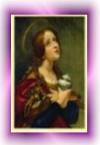He was born in 1102 on a farm near Saint-Maurice-l’Exil, not far from the Cistercian Bonnevaux Abbey. His father often offered hospitality to the monks, when they had to leave the monastery on business. St Peter joined this Cistercian monastery at the age of 20 in 1122. He lived with such modesty, charity and humility that people were moved and inspired to conversion, by his great holiness. He was such a great witness of the religious life that many others followed him and joined the abbey as well. In fact, his whole family followed him and joined communities of their own—his mother, father, and siblings.
He was appointed as Abbot of the new monastery that he was instrumental in establishing, in the mountains. This monastery soon became known as a resting place for travelers. Peter began a hospice there for sick and poor travelers.
In 1142, at the insistence of his superiors including St Bernard of Clairvaux, Abbot Peter reluctantly accepted the position as the Archbishop of Tarentaise. In his episcopal role he applied the Cistercian principles to restore the diocese and met with a good deal of success, since the diocese’s management had declined and discipline lax. He removed corrupt priests (and elevated good priests to important pastoral positions) and promoted education for all the faithful. He visited all parts of his mountainous diocese on a regular basis. He also frequently visited the Grand Chartreuse, during the tenure of Hugh of Lincoln.
His specific concerns included the welfare of travellers to and from Switzerland and from the Italian cities. He rebuilt a hospice in poor repair at Little St Bernard Pass. He also founded a charity which distributed food to farms in the surrounding hills. This would become known as pain de Mai and became a tradition continued in the region until the French Revolution.
Miracles were attributed to him during this time—healings and the multiplication of food during a famine. He became widely known as a wonder-worker, which increased his longing for the solitude he found in his life as a monk. After 13 years as archbishop, in 1155, he one day suddenly vanished without a trace.. He was discovered one year later in a remote Cistercian abbey in Switzerland, where he had joined the community under an assumed name as a lay brother. He was ordered to return and was warmly greeted when he got back to Tarentaise. He redoubled his efforts at leading the diocese, and took even greater care of the poor—twice he endangered his own life by giving away his own cloak in severe weather.
Religious and state authorities turned to Peter, a man of great peace, in moments of conflict so that he could effect reconciliation with his words and presence. He preached outspokenly and fearlessly, in disputes over the papacy and between the kings of France and England and his words were backed by miracles of healings.
Pierre died in 1174 as he attempted to mediate between feuding monarchs after a serious but brief illness. For his charity and healing powers, Peter was viewed as a saint even in his lifetime. His Canonization was formalized under Pope Celestine III in 1191.

